 |
Matronics Email Lists
Web Forum Interface to the Matronics Email Lists
|
| View previous topic :: View next topic |
| Author |
Message |
frans(at)privatepilots.nl
Guest
|
 Posted: Sun Aug 19, 2012 5:46 am Post subject: Wheel fairings Posted: Sun Aug 19, 2012 5:46 am Post subject: Wheel fairings |
 |
|
On 08/12/2012 07:24 PM, Bud Yerly wrote:
| Quote: | Frans,
I'll look for some pictures. I don't have them at the home office today.
|
The reason I was asking is that I'm in the process of making some
improved wheel fairings. It would be nice to share some ideas to the
benefit of all of us, which is the purpose of this forum.
Well, I have some ideas to share. I started with the nose wheel fairing
because there is only one of it so I only have to make one test sample,
and I disliked the original nose wheel fairing more than the main wheel
fairings.
To improve on something, one first has to identify the shortcomings. For
me, the shortcomings of the original fairing are:
1) Poor fit. We all experienced that the thing was impossible to get
symmetric. (I have been told that the company now corrected this error
but that didn't solve my problem with the already bought fairing).
2) It is wider than necessary. Apart from the obvious aerodynamic
disadvantage, the extra width also implies that the fairing has to bend
in sharply at the underside to meet up with the smaller wheel. This bend
further creates interference drag, and it increases vulnerability to
objects on the ground. Ideally, the fairing's bottom should not be wider
than the track of the wheel.
3) Too weak. Partly as a result of the width, but also due to the
material itself.
4) The vertical division into two halves. These halves do not match well
together, they meet at an angle and often bulge out, disrupting the
airflow up front and negating the main purpose of the rest of the
fairing behind it.
5) The clutter caused by all the fasteners, all on a separate height.
Add a hole at the axle for a tow bar, and there are 5 levels (on each
side!) where the airflow gets disrupted.
6) Too small in height. I would like to hide more of the wheel, and I
also would like to fair in my 3cm shaft extension. (This mod was
necessary to allow a larger diameter prop and still maintain enough
ground clearance).
7) Too short. The length might be theoretically right, but if the
fairing is not aligned perfectly with the airflow it should be longer to
allow a shallow decline of the "downwind" side of the fairing to keep
the airflow attached. And the fairing is likely not aligned perfectly,
due to the proximity of the prop, and it is also quite possible that
during take off the nose wheel turns a bit to a side while leaving the
ground, especially while taking of in a cross wind.
How did I improve on all this?
1) A key decision was to make the fairing from aramide (kevlar) instead
of glass. Aramide has less tensile strength than glass or carbon, but it
won't crack and it is highly resistant to impact forces. If it is
literally(!) bullet proof, it should also cope well with rocks and
bumps. The downside is that the material is hard to handle, you can
forget about using normal scissors and knifes. We made part of a test
fairing with two layups of aramide and had great fun trying to destroy
it once it was cured. We jumped on it so it pancaked, but it just popped
back into shape after we left it, without any damage. We actually folded
it, the epoxy itself cracked a bit but not a single strand broke and it
folded right back into its original shape (but of course this time with
a visible fold line). If I were living in the US I would probably also
have fired some bullets at it just for laughs. This material allowed me
to make a much deeper fairing and still don't have to worry about soft
fields and hitting some rocks, while keeping the weight low at the same
time. On the final fairing we tested it by taking the wheel off the
ground, putting obstacles below the fairing and putting the aircraft on
its own weight again, so that the entire weight of the aircraft was
resting on the fairing. No problem. It will probably survive a flat tire
with only some paint damage. We could probably land on it without any
wheel inside at all.
2) A decision was made to keep the axle nuts outside of the fairing. We
needed an attach point for the tow bar anyway, and it would either be a
hole or a small protrusion. By keeping the axle ends outside of the
fairing I could make the fairing more than 5 cm (2 inches) smaller!
Also, I could eliminate the arms (saving additional width and weight)
and fasteners (leaving the rest of the fairing smooth), by just
embedding two metal plates in the layups and using the axle bolts itself
to fasten the fairing. Now the fairing got significantly smaller, also
the theoretical length would be smaller. Because I wanted a longer
fairing, I just kept the length of the original fairing to get the ratio
I wanted. And because the fairing is so small, it is easy to make a
natural transition into the wheel at the bottom of the fairing without
any curve or flat part on the sides of the underside.
3) Instead of the vertical division, I wanted a lengthwise division so
the cut would be in line with the airflow. Instead of dividing it into
two halves, Ilona came up with the idea to make a cut so that a part of
the bottom can be taken off. This allows the wheel to enter, and it
makes the vulnerable bottom part to be easily replaceable. Also, it
gives the interesting option to fly with the bottom removed in winter
time, to give more clearance for the wheel and to allow mud and snow to
fall out by itself.
A few notes:
The upper part of the fairing is wider than the lower part. This is
because the upper part must also encapsulate the yoke. If then a
straight angle to the rear is followed, the rear of the fairing
automatically gets this "swept back" appearance and its curved
underside. This is also the reason that the "nose" is above the center
of the wheel.
Of course the bottom of the fairing is a bit of a compromise to get
enough clearance on ramps and to blend in the profile of the wheel as
good as possible.
The "skirts" on the side are purposedly not rigid. They will give way if
something catches between the tire and the skirt.
I made the shape of blue foam, and decided to leave it inside except of
course for the cavity of the wheel. This adds further strength for a
very low weight penalty.
There is a small "bulge" in the division cut on the port side, this is
to facilitate access to the valve of the tire. I only have to drop the
underside of the fairing to get access to it.
To remove the entire fairing, the wheel assembly must be taken off.
There is however not much need to remove the fairing, as even the wheel
can be taken out of the yoke without removing the upper part of the fairing.
The fairing is reinforced near the shaft. This forms the third
attachment point, so that the fairing can not rotate over the axle.
There is additional clearance at the rear of the tire, so the wheel can
never "catch" the fairing.
The yellow appearance of the fairing is due to the color of the aramide
cloth. The ragged appearance of edges is also due to the aramide. Of
course the fairing will receive a proper finish.
This is a one of design, however if someone wants to use it as a plug
that is possible. Keep in mind though that it is designed for nose wheel
assemblies with a 3cm longer shaft than original.
Frans
| | - The Matronics Europa-List Email Forum - | | | Use the List Feature Navigator to browse the many List utilities available such as the Email Subscriptions page, Archive Search & Download, 7-Day Browse, Chat, FAQ, Photoshare, and much more:
http://www.matronics.com/Navigator?Europa-List |
|
| Description: |
|
| Filesize: |
37.28 KB |
| Viewed: |
1358 Time(s) |

|
| Description: |
|
| Filesize: |
22.91 KB |
| Viewed: |
1358 Time(s) |
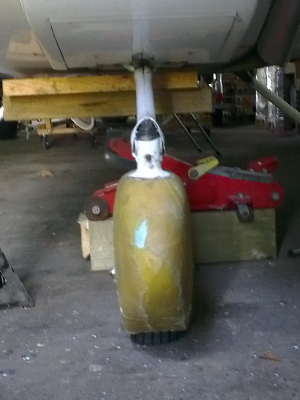
|
| Description: |
|
| Filesize: |
63.82 KB |
| Viewed: |
1358 Time(s) |
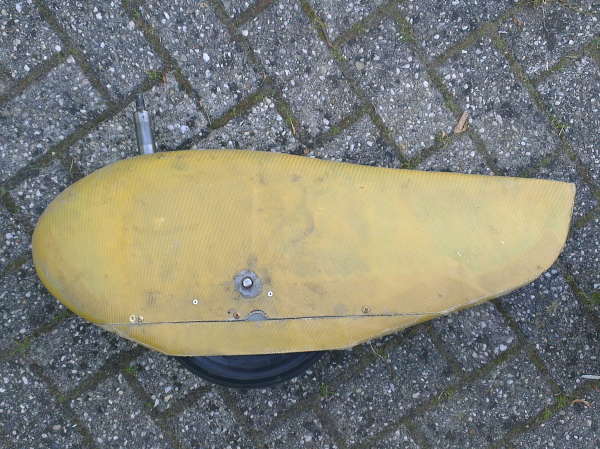
|
| Description: |
|
| Filesize: |
15.21 KB |
| Viewed: |
1358 Time(s) |
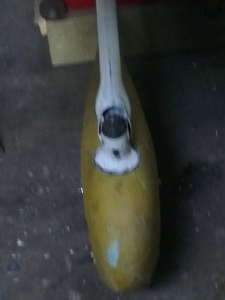
|
| Description: |
|
| Filesize: |
50.01 KB |
| Viewed: |
1358 Time(s) |
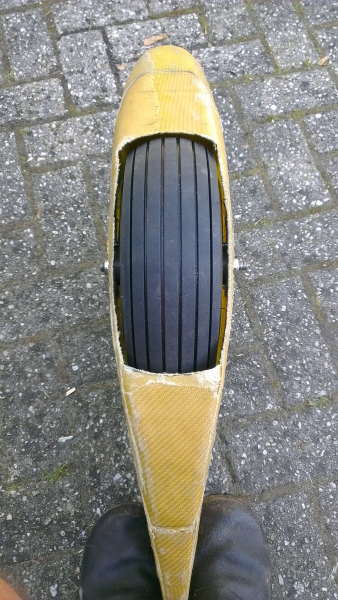
|
| Description: |
|
| Filesize: |
45.66 KB |
| Viewed: |
1358 Time(s) |
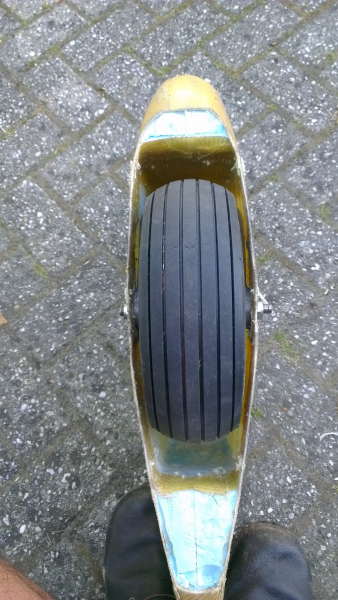
|
|
|
| Back to top |
|
 |
Fred Klein
Joined: 26 Mar 2012
Posts: 503
|
 Posted: Sun Aug 19, 2012 6:12 am Post subject: Wheel fairings Posted: Sun Aug 19, 2012 6:12 am Post subject: Wheel fairings |
 |
|
On Aug 19, 2012, at 6:45 AM, Frans Veldman wrote:
| Quote: | The reason I was asking is that I'm in the process of making some improved wheel fairings. It would be nice to share some ideas to the benefit of all of us, which is the purpose of this forum.
Well, I have some ideas to share. |
Frans...
I tip my hat to you and IIona...I salute your analysis, design, and execution...very nice work!
Fred
[quote][b]
| | - The Matronics Europa-List Email Forum - | | | Use the List Feature Navigator to browse the many List utilities available such as the Email Subscriptions page, Archive Search & Download, 7-Day Browse, Chat, FAQ, Photoshare, and much more:
http://www.matronics.com/Navigator?Europa-List |
|
|
|
| Back to top |
|
 |
craigb(at)onthenet.com.au
Guest
|
 Posted: Sun Aug 19, 2012 12:42 pm Post subject: Wheel fairings Posted: Sun Aug 19, 2012 12:42 pm Post subject: Wheel fairings |
 |
|
Frans, could you elaborate on the "correct length would be shorter" wouldn't
the longer shallower transition
Create less drag and thus make your longer fairing more efficient.
Regards
craig
| | - The Matronics Europa-List Email Forum - | | | Use the List Feature Navigator to browse the many List utilities available such as the Email Subscriptions page, Archive Search & Download, 7-Day Browse, Chat, FAQ, Photoshare, and much more:
http://www.matronics.com/Navigator?Europa-List |
|
|
|
| Back to top |
|
 |
frans(at)privatepilots.nl
Guest
|
 Posted: Sun Aug 19, 2012 2:38 pm Post subject: Wheel fairings Posted: Sun Aug 19, 2012 2:38 pm Post subject: Wheel fairings |
 |
|
On 08/19/2012 10:41 PM, craig wrote:
| Quote: |
Frans, could you elaborate on the "correct length would be shorter" wouldn't
the longer shallower transition
Create less drag and thus make your longer fairing more efficient.
|
There is also something like skin drag. More surface creates more drag.
So there is an optimum somewhere: for a 2D fairing (like for a strut or
a wheel leg) the optimal width to length ratio would be 1:3.7, with the
widest point at about 30% of the length. For a 3D fairing things get a
bit more complicated. Shorter carries a higher penalty than longer, so
if in doubt just make it longer.
Frans
| | - The Matronics Europa-List Email Forum - | | | Use the List Feature Navigator to browse the many List utilities available such as the Email Subscriptions page, Archive Search & Download, 7-Day Browse, Chat, FAQ, Photoshare, and much more:
http://www.matronics.com/Navigator?Europa-List |
|
|
|
| Back to top |
|
 |
|
|
You cannot post new topics in this forum
You cannot reply to topics in this forum
You cannot edit your posts in this forum
You cannot delete your posts in this forum
You cannot vote in polls in this forum
You cannot attach files in this forum
You can download files in this forum
|
Powered by phpBB © 2001, 2005 phpBB Group
|








